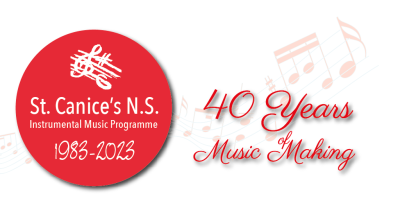The video shows Lauren Walsh 6th Class 2013-2014 interviewed and performing in Senior Orchestra in the programme “Meet The Orchestra” recorded in May 2013 and aired on RTE Junior in September 2013
The baritone is a member of the brass family. As with all brass instruments, the sound is produced by buzzing the lips into a mouthpiece.
The baritone works in the same manner as a trumpet but it’s twice the length. It plays the exact same notes as a trombone and even uses the same mouthpiece. The biggest difference is that the baritone uses valves rather than a slide to change the length of the air flow.
The baritone is stored in the case in just two pieces. It is played with the right hand on the valves. The left arm usually supports the bottom of the instrument. There are a number of shapes and sizes of baritones. The difference in sizes for baritones is caused by how tightly the the tubing is coiled. Very small “baby” baritones look about half the size of a regular baritone but they are really the same length and the same pitch. The tubing is just coiled tighter.
The baritone is not nearly as popular as other brass and woodwind instruments Less students performing an instrument means that the competition will not be as fierce. Good baritone players are considered very valuable assets by orchestras and bands since there are so few of them.
The baritone has unique uses in various types of groups. We can hear baritones in bands, small ensembles or as a solo instrument. On the professional level, baritones are used heavily in military bands.
St Canice’s baritone players perform in the Junior orchestra and Senior orchestra and may also get together with fellow brass, woodwind or string players to form smaller performing groups.
All instruments have limited availability and will be distributed for hire on a first come first served basis. Baritones are available for hire for two years. Lesson costs depend on the size of the group being taught and can alter annually. Please ask for further details.
